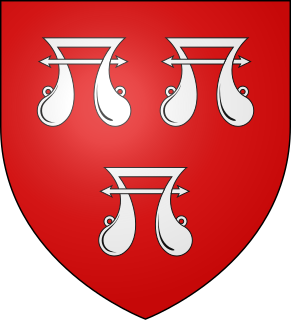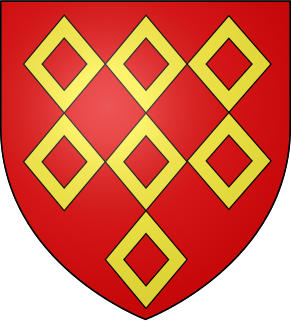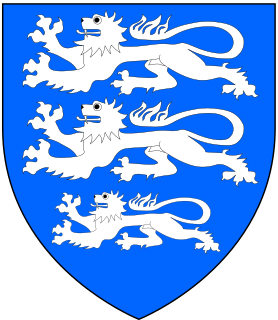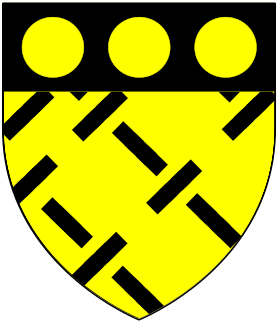
Roger de Quincy, 2nd Earl of Winchester, hereditary Constable of Scotland, was a nobleman of Anglo-Norman and Scottish descent who was prominent in both England and Scotland, at his death having one of the largest baronial landholdings in the two kingdoms.

Ralph de Stafford, 1st Earl of Stafford, 2nd Baron Stafford, KG, of Stafford Castle and Madeley Castle in Staffordshire, was an English nobleman and a notable soldier during the Hundred Years' War against France.

William Ros or Roos, 1st Baron Ros of Helmsley, was one of the claimants of the crown of Scotland in 1292 during the reign of Edward I.

William III de Ferrers, 5th Earl of Derby of Chartley Castle in Staffordshire, was an English nobleman and major landowner, unable through illness to take much part in national affairs. From his two marriages, he left numerous children who married into noble and royal families of England, France, Scotland and Wales.
Peter de Montfort of Beaudesert Castle was an English magnate, soldier and diplomat. He is the first person recorded as having presided over Parliament as a parlour or prolocutor, an office now known as Speaker of the House of Commons. He was one of those elected by the barons to represent them during the constitutional crisis with Henry III in 1258. He was later a leading supporter of Simon de Montfort, 6th Earl of Leicester against the King. Both he and Simon de Montfort were slain at the Battle of Evesham on 4 August 1265.

Baron Ferrers of Groby was a title in the Peerage of England. It was created by writ on 29 December 1299 when William Ferrers, 1st Baron Ferrers of Groby was summoned to parliament. He was the son of Sir William de Ferrers, Knt., of Groby, Leicestershire, (d.1287) by his first wife Anne Durward, 2nd daughter of Alan Durward and his wife Margery of Scotland, and grandson of William de Ferrers, 5th Earl of Derby. The first Baron was married to Ellen de Menteith, daughter of Alexander, Earl of Menteith. In 1475 the eighth baron was created the Marquess of Dorset, and the barony in effect merged with the marquessate. It was forfeited along with the marquessate when the third marquess was attainted in 1554.
Alexander of Menteith, a Scottish nobleman and member of the Stewart family, he was the Earl of Menteith.

Walter Devereux, 10th Baron Ferrers of Chartley, created 1st Viscount Hereford, KG was an English courtier and parliamentarian.

Bryan FitzAlan, Baron FitzAlan Knt. was Lord of the Manor of Bedale in Richmondshire, Askham Bryan in the Ainsty, Bainton, Heworth &c., in Yorkshire, Bicker and Graby in Lincolnshire, a J.P. &c. He was appointed a Guardian of Scotland on 13 June 1291, and was brother-in-law to King John of Scotland.
Isabel de Verdun, Baroness Ferrers of Groby was an heiress, who was related to the English royal family as the eldest daughter of Elizabeth de Clare, herself a granddaughter of King Edward I of England. When she was a child, Isabel was imprisoned in Barking Abbey, along with her mother and half-sister, after her stepfather had joined the Earl of Lancaster's ill-fated rebellion against King Edward II. Her husband was Henry Ferrers, 2nd Baron Ferrers of Groby.

Henry Percy, 9th Baron Percy of Topcliffe, 2nd Baron Percy of Alnwick was the son of Henry de Percy, 1st Baron Percy of Alnwick, and Eleanor Fitzalan, daughter of Sir Richard FitzAlan, 8th Earl of Arundel, and sister of Edmund FitzAlan, 9th Earl of Arundel.
Baron Astley (1295) was created by writ of summons dated 23 June 1295 for a family which had lived at Astley, Warwickshire, England since the time of Henry I. Sir Thomas de Astley who was killed in the Battle of Evesham in 1265 married twice. From Sir Thomas's first marriage to Joan de Blois descended the Barons Astley.

William Ferrers, 1st Baron Ferrers of Groby was an English peer who lived under two kings, Edward I and Edward II. His baronial caput was Groby in Leicestershire.

Henry Ferrers, 2nd Baron Ferrers was the son of William Ferrers, 1st Baron Ferrers of Groby and his wife Ellen. Henry Ferrers has been described by one recent historian as "arguably the most successful member of his family" on account of his being the only one, in six generations, to have succeeded to his patrimony as an adult, thus "protecting his inheritance from the hazards of wardship."

Henry Ferrers, 4th Baron Ferrers of Groby (1356–1388) was a fourteenth century English nobleman. He was a professional soldier, taking part in a number of campaigns during the reign of Richard II, served on several royal commissions, was a justice of the peace and a member of parliament.

William Ferrers, 5th Baron Ferrers of Groby (1372–1445) was an English baron in the late middle ages. He was an important figure in Leicestershire society and took part in most of the royal commissions that were held there. He was also active at a national level and earlier in his career he took part in some of the crises in the reigns of both King Richard II and Henry IV. However, he supported the Lancastrian regime under Henry V and acted as a councillor to that King's baby son when the latter inherited the throne at the age of six months. Ferrers was married three times, twice to daughters of the peerage. Because his eldest son died before him, the Ferrers barony descended to his granddaughter's husband. Thus, when William Ferrers died, the Ferrers line, which had begun in England with the Norman conquest, after which they were first granted lands in Leicestershire came to an end.
Theobald de Verdun (1278–1316) was the second and eldest surviving son of Theobald de Verdun, 1st Baron Verdun, of Alton, Staffordshire, and his wife Margery de Bohun. The elder Theobald was the son of John de Verdon, otherwise Le Botiller, of Alton, Staffordshire, who was killed in Ireland in 1278. John in turn was the son of Theobald le Botiller and Roesia de Verdun. Roesia was the daughter of Nicholas de Verdun, who was the son of Bertram III de Verdun. When King Henry II invaded Ireland in 1171, this Bertram was appointed Seneschal for the undertaking, that is to say he was responsible for provisions and stores.

Baron Camville was a title created in the Peerage of England for Geoffrey de Camville II, of Clifton Campville in Staffordshire, who having been summoned to Parliament on 24 June 1295 and subsequently, by writs directed to Galfrido de Caunvilla, Caumvilla, Canvilla or Camvilla, was deemed thereby to have been created Baron Camville.

The Ferrers family were a noble Anglo-Norman family that crossed to England with the Norman Conquest and gave rise to a line that would hold the Earldom of Derby for six generations before losing it in rebellion. They also gave rise to several lines that held English peerages, the longest-living going extinct in the male line in the 15th century, as well as a Norman branch of the family that persisted into the 13th century. A French line persisted into the 16th century.

Baron St Amand was a title created twice in the Peerage of England: firstly in 1299 for Amauri de St Amand (1269–1310), who died without issue, when it became extinct; and secondly in 1313 for his brother John de St Amand (1283/6–1330).











